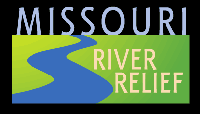 |
| Darcy Higgins leads a group discussion. |
Overview:
During the 2016-17 school year, 4th grade students from five Columbia Area Public Elementary Schools had the fortunate opportunity to participate in the Missouri River All Stars after-school program, hosted by Missouri River Relief (MRR). The goal of the program was to engage student’s innate sense of wonder and natural curiosity to explore the Missouri River, while increasing their knowledge and understanding of the Missouri River to deepen their connection and sense of responsibility to its care and stewardship.
 |
| Students use maps to learn about the Missouri River. |
During the program, students learned about the Missouri River by working in teams to develop their own knowledge of the Missouri River. The program was divided into five lessons, four taking place in the classroom and one on the river. The lessons are founded upon MRR’s Core Education Curriculum, which seeks to develop students’ understanding through three distinct contexts: Knowledgeable Ecologist, Insightful Historian, and Conscientious Community Member. These ‘roles’ guide our lesson plans, and facilitate an environment that is diverse and abundant with substantive information, which results in a well-rounded educational program.
 |
| Eager curiosity flows through this excited group of students. |
The first lesson, titled Connecting to the Missouri River, serves as an introduction to the program. In this lesson, students began to explore their own connection to the river by expanding their sense of wonder and curiosity. Using several maps, students learned about different historical perspectives of the river, and how uses of it have changed over time.
 |
| Students construct maps detailing the life cycle of Pallid Sturgeon. |
The second lesson, Behind the Scenes of the Missouri River, shifted the attention towards ecological factors that influence the river. Students explored the interconnectedness of the river’s ecosystem, and how diversity helps shape the ecological balance. Focusing on the Pallid Sturgeon, students followed the life cycle of an organism, and how it reacts to both abiotic and biotic factors in the river.
 |
| What's a better way to learn than through hands-on experience? |
The third lesson, Forces that Shape the Missouri River, built on the ecological aspects learned in lesson two, but added human factors, and how economic, environmental, and social systems interact with the river. Focus was placed on human actions, and the immediate impacts that can have a cumulative and long-lasting effect on the river. Artificial constructs, such as dams and channels, were the centerpiece for activities in this lesson.
 |
| Students join together in exploration. |
The fourth in-class lesson, Connecting Others to the Missouri River, sought to strengthen students’ sense of responsibility and care to the Missouri river. Students identified ways in which the watershed is a shared resource, and how impacts can be felt in communities that are many miles apart. Focus was placed on environmental stewardship, and developing skills that students can readily apply, strengthen, and share with their family, friends, school, and community. Significant historical figures, such as Aldo Leopold and Mark Twain, ignited students’ creativity as they worked in small groups to design possible solutions for ecosystem restoration or trash clean up.
 |
| Students find shade as they listen in. |
Field Trip:
The final lesson for the All Star program was an all-day outing on the Missouri River, taking place at Katfish Katy’s in Huntsdale, MO. Beginning at 10 AM, students arrived and were split into groups of 25, rotating between four different stations in 40-minute intervals.
 |
| Questions abound during this engaging discussion. |
The first station, Experience the River, was a boat ride on the Missouri River, where students were privileged to spectacular views, as well as in-depth information about the channelization of the river.
 |
| With life jackets secured, students get ready for a boat ride on the Mighty Mo. |
The second station, Through the Eyes of an Explorer, had students take a journey back in time. Hosted by local artist, Gale Johnson, students investigated the journals of Lewis and Clark, and made watercolor sketches using the river for creative inspiration.
 |
| Gale Johnson speaks to the students about Lewis and Clark |
The third station, Meet a Fisheries Biologist, allowed students to interact with some of the fish that call the Missouri River home. Dr. Rosenberger, a professor at Mizzou, accompanied by some MU students hosted a presentation that described the work that professionals are doing to help the river’s ecosystem.
 |
| Students gather around for a closer look at some Big Muddy fish. |
The fourth station, Birds of the River, provided students with tons of information about different birds that live along the river. Paige Witek, from the Missouri River Bird Observatory, guided students as they investigated the natural history of birds and how they have specifically adapted to the river ecosystem.
 |
| Smiles all around after the boat ride. |
After all groups had a chance to participate in the different stations, students departed at around 2:30 PM. What a great send-off this was for this year’s All Stars, serving as a fun and engaging culmination of the program. MRR plans to provide an All Stars program for next year’s class as well, so to stay up-to date on information, make sure to contact Kristen at kristen@riverrelief.org and check out our All Stars page.
 |
| Sad to see you go! Students gather before departure. |
See you on the river!

No comments:
Post a Comment